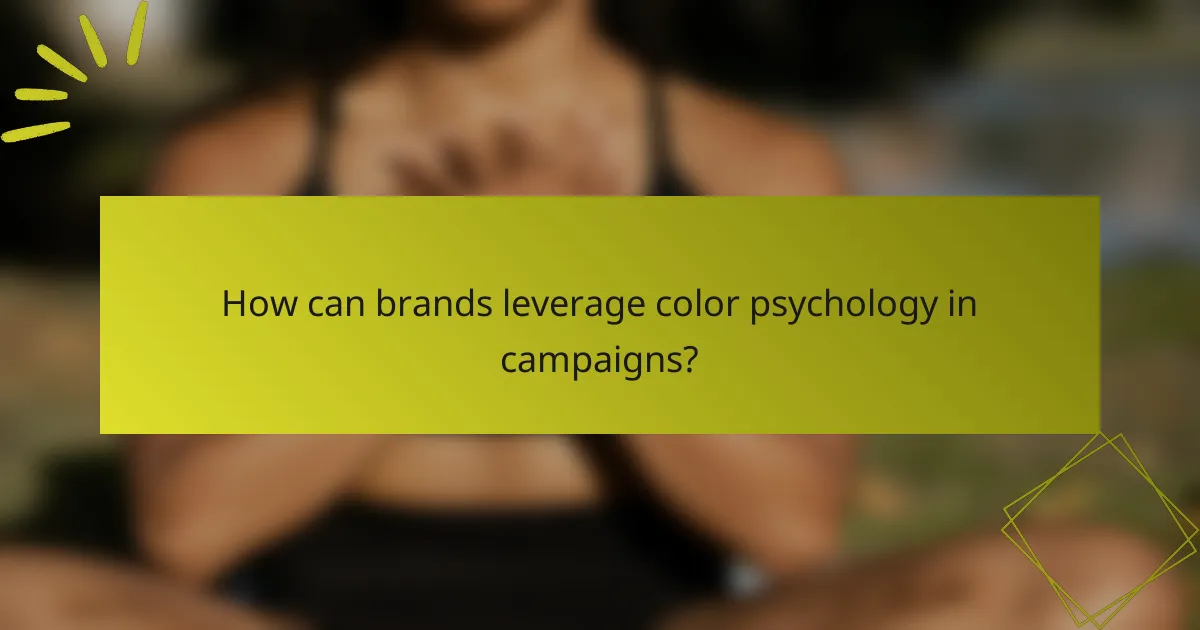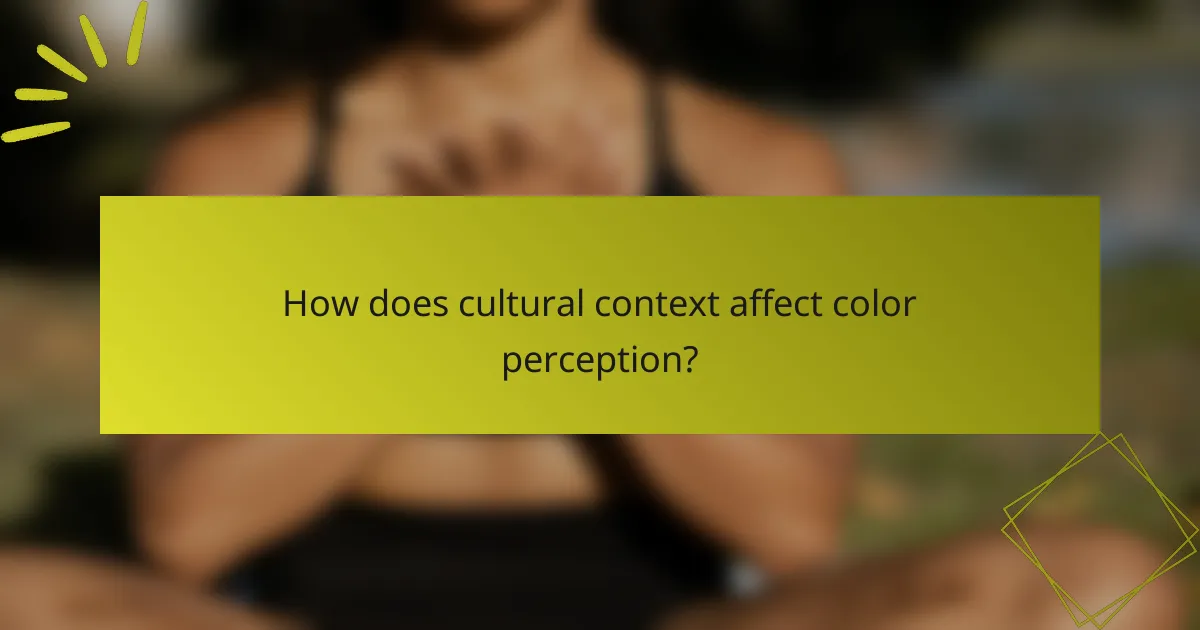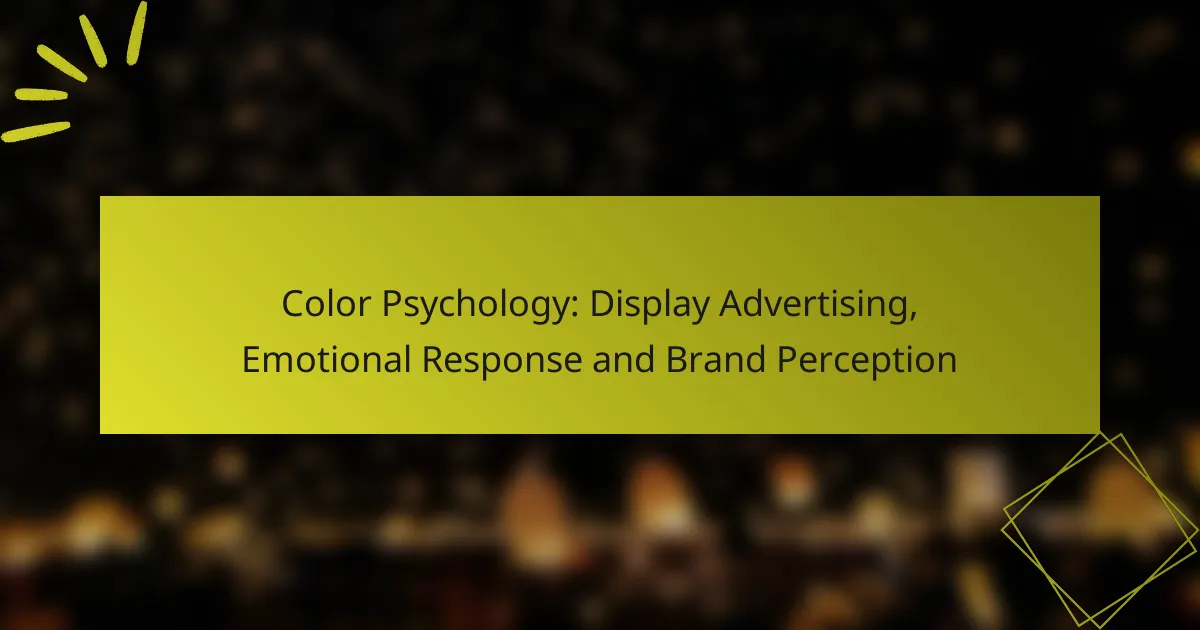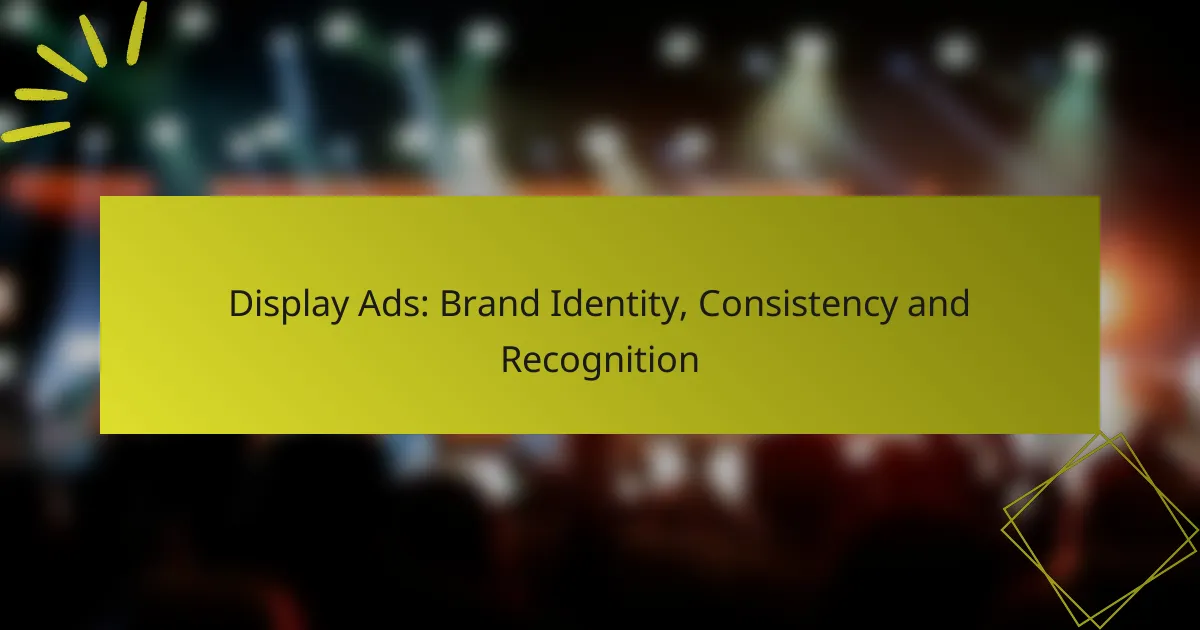Color psychology plays a crucial role in display advertising by influencing how consumers perceive brands and respond emotionally to marketing messages. By strategically using colors like red, blue, and green, advertisers can evoke specific feelings that enhance brand effectiveness and resonate with their target audience. Understanding these psychological impacts allows marketers to create compelling advertisements that foster positive brand perception and drive consumer engagement.

How does color psychology impact display advertising?
Color psychology significantly influences display advertising by shaping consumer perceptions and emotional responses. Different colors evoke specific feelings and associations, which can enhance or detract from a brand’s message and effectiveness.
Influence on consumer emotions
Colors can trigger various emotional responses, impacting how consumers feel about a brand. For instance, blue often conveys trust and calmness, while red can evoke excitement or urgency. Understanding these emotional triggers helps advertisers select colors that align with their desired brand image.
When designing ads, consider the target audience’s cultural background, as color meanings can vary widely. For example, white symbolizes purity in Western cultures but may represent mourning in some Eastern cultures. Tailoring color choices to the audience’s emotional landscape can enhance engagement.
Effect on brand recognition
Consistent use of specific colors can significantly improve brand recognition. Research indicates that color can increase brand recognition by up to 80%. Brands like Coca-Cola and Tiffany & Co. are prime examples of how distinctive color palettes can become synonymous with their identities.
To leverage this effect, brands should establish a color scheme that reflects their values and resonates with their audience. Maintaining consistency across all marketing materials, from online ads to packaging, reinforces brand identity and aids recall.
Color associations with products
Colors are often associated with particular products or industries, influencing consumer expectations. For example, green is commonly linked to health and sustainability, making it a popular choice for organic products. Similarly, black is often associated with luxury and sophistication.
When selecting colors for display advertising, consider the product’s category and the emotions you want to evoke. Aligning color choices with consumer expectations can enhance the effectiveness of the advertisement and improve the likelihood of conversion.

What are the key colors used in display advertising?
Key colors in display advertising include red, blue, and green, each evoking specific emotional responses and influencing brand perception. Understanding these colors can help marketers design effective advertisements that resonate with their target audience.
Red for urgency and excitement
Red is often associated with urgency and excitement, making it a powerful choice for calls to action. Brands frequently use red to create a sense of immediacy, encouraging consumers to act quickly, such as during sales or limited-time offers.
When using red in advertising, consider its impact on the viewer’s emotions. It can stimulate appetite and increase heart rates, which is why it’s popular in food marketing. However, overuse can lead to feelings of aggression or anxiety, so balance is key.
Blue for trust and dependability
Blue is widely recognized for conveying trust and dependability, making it a favorite among financial institutions and healthcare brands. This color promotes a sense of security, which can enhance customer loyalty and brand reputation.
Incorporating blue into display advertising can help establish a calm and professional image. It’s advisable to use various shades of blue to match the brand’s personality—darker blues often suggest professionalism, while lighter blues can evoke tranquility.
Green for health and tranquility
Green is commonly linked to health, tranquility, and nature, making it an ideal choice for brands focused on wellness or sustainability. This color can create a refreshing and calming effect, appealing to consumers’ desires for a balanced lifestyle.
When utilizing green in advertising, it’s effective to pair it with natural images or themes. This reinforces the message of health and environmental consciousness. However, too much green can feel monotonous, so consider integrating complementary colors to enhance visual interest.

How can brands leverage color psychology in campaigns?
Brands can effectively leverage color psychology in their campaigns by selecting colors that evoke specific emotions and align with their target audience’s preferences. Understanding the psychological impact of colors can enhance brand perception and drive consumer engagement.
Choosing colors based on target audience
Selecting colors that resonate with a target audience is crucial for effective advertising. For instance, younger audiences may respond well to vibrant and bold colors, while older demographics might prefer more muted and classic tones. Conducting surveys or focus groups can help identify color preferences among different segments.
Consider cultural differences as well; colors can have varying meanings across cultures. For example, while white symbolizes purity in many Western cultures, it may represent mourning in some Eastern societies. Tailoring color choices to cultural contexts can enhance relatability and acceptance.
Aligning colors with brand values
Colors should reflect the core values and mission of a brand. For example, green is often associated with sustainability and health, making it a suitable choice for eco-friendly brands. In contrast, luxury brands may opt for black or gold to convey sophistication and exclusivity.
Consistency in color usage across all marketing materials reinforces brand identity. When a brand consistently uses its chosen colors, it builds recognition and trust among consumers, making it easier for them to connect emotionally with the brand.
Testing color combinations for effectiveness
Testing different color combinations can significantly impact the effectiveness of advertising campaigns. A/B testing allows brands to compare how different color schemes perform in terms of engagement and conversion rates. This method provides valuable insights into which colors resonate best with the audience.
When testing, consider using a mix of colors that complement each other rather than clash. Tools like color wheel applications can help identify harmonious color combinations. Additionally, analyzing competitors’ color strategies can provide inspiration and help identify gaps in the market.

What are the emotional responses to different colors?
Different colors evoke specific emotional responses that can significantly influence consumer behavior and brand perception. Understanding these reactions can help businesses tailor their display advertising to elicit desired feelings and actions from their target audience.
Yellow for optimism and cheerfulness
Yellow is often associated with optimism, cheerfulness, and warmth. It can create a sense of happiness and energy, making it an effective choice for brands aiming to convey positivity.
When using yellow in advertising, consider its brightness and saturation. Lighter shades can evoke feelings of joy, while darker yellows may suggest caution. Brands like McDonald’s utilize yellow to attract attention and create a welcoming atmosphere.
However, excessive use of yellow can lead to feelings of frustration or anxiety. Balance it with complementary colors to maintain a positive emotional response without overwhelming viewers.
Purple for luxury and creativity
Purple is commonly linked to luxury, creativity, and sophistication. It often conveys a sense of elegance and can attract consumers looking for premium products or services.
Incorporating purple into display advertising can enhance brand perception, especially for businesses in the beauty, fashion, or high-end markets. Brands like Cadbury use purple to signify richness and indulgence, appealing to consumers’ desires for quality.
While purple can be powerful, it’s essential to use it thoughtfully. Pairing it with lighter colors can soften its impact and make it more accessible, avoiding an overly opulent feel that may alienate some consumers.

How does cultural context affect color perception?
Cultural context significantly influences how individuals perceive colors, impacting emotional responses and brand perception. Different cultures associate specific colors with varying meanings, which can affect how advertising messages are received and interpreted.
Variations in color meanings across cultures
Colors can evoke distinct emotions and associations depending on cultural backgrounds. For example, while white is often linked to purity and weddings in Western cultures, it can symbolize mourning in some Eastern cultures. Similarly, red may signify good fortune in China but can represent danger or caution in other contexts.
Understanding these variations is crucial for brands aiming to connect with diverse audiences. Conducting cultural research can help identify the appropriate color schemes that resonate positively with target demographics.
Impact of regional preferences on advertising
Regional preferences play a vital role in shaping effective advertising strategies. For instance, in markets like the United States, vibrant colors may attract attention, while more subdued tones might be favored in European countries. Tailoring color choices to align with local tastes can enhance brand appeal and engagement.
Brands should also consider seasonal and cultural events that influence color preferences. For example, during festive seasons, colors like green and red may be more appealing in Western markets, while gold and silver might be preferred in Middle Eastern regions. Adapting to these preferences can lead to more successful advertising outcomes.

What frameworks can guide color selection in advertising?
Several frameworks can assist in selecting colors for advertising, focusing on emotional impact and brand identity. Utilizing these frameworks helps create effective visual communication that resonates with target audiences.
Color wheel and harmony principles
The color wheel is a fundamental tool in color selection, illustrating the relationships between colors. Understanding primary, secondary, and tertiary colors allows advertisers to create harmonious combinations that evoke specific emotions.
Using harmony principles, such as complementary, analogous, or triadic schemes, can enhance visual appeal. For example, a complementary color scheme pairs colors opposite each other on the wheel, creating contrast and vibrancy, which can grab attention effectively.
Brand color guidelines and consistency
Establishing brand color guidelines is crucial for maintaining consistency across all advertising platforms. Consistent use of specific colors reinforces brand identity and helps consumers recognize and trust the brand.
When developing these guidelines, consider the psychological associations of colors. For instance, blue often conveys trust and reliability, making it a popular choice for financial services. Ensure that all marketing materials adhere to these guidelines to strengthen brand perception.

What are the latest trends in color usage for display ads?
Recent trends in color usage for display ads emphasize bold, vibrant colors that capture attention and evoke emotional responses. Brands are increasingly using color psychology to enhance brand perception and drive engagement.
Bold and Vibrant Colors
Bold and vibrant colors are becoming more popular in display advertising as they stand out in crowded digital spaces. Bright hues like electric blue, vivid orange, and neon green are often used to attract attention and create a sense of urgency.
These colors can evoke strong emotional responses, making them effective for campaigns aimed at younger audiences. For example, a brand targeting millennials might use a bright color palette to convey energy and excitement.
Minimalist Color Schemes
Conversely, minimalist color schemes are gaining traction for their clean and sophisticated look. Brands are opting for muted tones and monochromatic palettes to convey simplicity and elegance.
This approach can enhance brand perception by promoting a sense of calm and reliability. For instance, tech companies often use shades of gray and white to project a modern and professional image.
Color Combinations and Contrast
Effective color combinations and high contrast are essential for ensuring readability and visual appeal in display ads. Using complementary colors can enhance the overall design while drawing attention to key elements.
For example, pairing a bright color with a neutral background can help important messages stand out. Brands should aim for a balance that maintains visual interest without overwhelming the viewer.
Cultural Considerations in Color Usage
Cultural context plays a significant role in color perception, making it crucial for brands to consider their target audience’s cultural background. Colors can have different meanings across cultures; for instance, red symbolizes luck in some Asian cultures but can signify danger in others.
Brands should conduct research to understand these nuances and tailor their color choices accordingly. This ensures that the intended emotional response aligns with cultural expectations, enhancing the effectiveness of the display ad.


